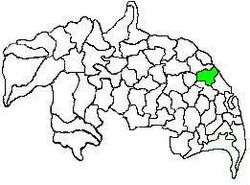Duggirala mandal
Duggirala mandal is one of the 57 mandals in Guntur district of the Indian state of Andhra Pradesh. It is under the administration of Tenali revenue division and the headquarters are located at Duggirala.[2] The mandal is bounded by Mangalagiri, Pedakakani, Tenali and Kollipara mandals. Krishna River lies to the northeast of the Duggirala mandal.[2]
Duggirala mandal | |
|---|---|
 Mandal map of Guntur district showing Duggirala mandal (in green) | |
.svg.png) Duggirala mandal Location in Andhra Pradesh, India | |
| Coordinates: 16°19′40″N 80°37′27″E | |
| Country | India |
| State | Andhra Pradesh |
| District | Guntur |
| Headquarters | Duggirala |
| Mandal Parishad villages | 14 |
| Government | |
| • Type | Panchayati raj (Block level) |
| • Body | Mandal Parishad |
| • Tehsildar | M.Sirisha |
| Population (2011)[1] | |
| • Total | 62,655 |
| Languages | |
| Time zone | UTC+5:30 (IST) |
Demographics
As of 2011 census, the mandal had a population of 62,655. The total population constitute, 31,269 males and 31,386 females —a sex ratio of 1004 females per 1000 males. 5,947 children are in the age group of 0–6 years, of which 2,999 are boys and 2,948 are girls. The average literacy rate stands at 70.97% with 40,244 literates.[1]
Administration
As of 19 June 2014, the present tahsildar is M.Sirisha.[3] It also forms a part of the Andhra Pradesh Capital Region under the jurisdiction of APCRDA.[4] Duggirala mandal is one of the three mandals under Mangalagiri (Assembly constituency), which in turn represents Guntur (Lok Sabha constituency) of Andhra Pradesh.[5]
Towns and villages
As of 2011 census, the mandal has 14 villages and no towns.[2] Duggirala is the most populated and Devarapalle Agraharam is the least populated villages in the mandal.[6]
The settlements in the mandal are listed below:
- Chiluvuru
- Chinapalem
- Chintalapudi
- Devarapalle Agraharam
- Duggirala(†)
- Emani
- Godavarru
- Kantamraju Konduru
- Morampudi
- Pedakondur
- Penumuli
- Perakalapudi
- Srungarapuram
- Tummapudi
Note: (†)-Mandal headquarters
Education
The mandal plays a major role in education for the rural students of the nearby villages. The primary and secondary school education is imparted by government, aided and private schools, under the School Education Department of the state.[7] As per the school information report for the academic year 2015–16, the mandal has more than 7,480 students enrolled in over 72 schools.[8][9]
See also
- List of mandals in Andhra Pradesh
- Villages in Duggirala mandal
References
- "Census 2011". The Registrar General & Census Commissioner, India. Retrieved 9 August 2014.
- "District Census Handbook : Guntur (Part A)" (PDF). Census of India. Directorate of Census Operations, Andhra Pradesh. 2011. pp. 5, 626–627. Retrieved 4 June 2019.
- "List of Tahsildars working in Guntur District as on 19.06.2014" (PDF). Guntur District Official Website. National Informatics Centre. p. 2. Archived from the original (PDF) on 16 October 2014. Retrieved 8 September 2014.
- "District wise mandals and villages covered in Krishna and Guntur districts" (PDF). Andhra Pradesh Capital Region Development Authority. Government of Andhra Pradesh. Archived from the original (PDF) on 23 September 2015. Retrieved 23 September 2015.
- "Delimitation of Parliamentary and Assembly Constituencies Order, 2008" (pdf). Election Commission of India. p. 22. Retrieved 11 October 2014.
- "Sub-District Details of Guntur District". The Registrar General & Census Commissioner, India. Archived from the original on 15 April 2015. Retrieved 9 August 2014.
- "School Education Department" (PDF). School Education Department, Government of Andhra Pradesh. Archived from the original (PDF) on 27 December 2015. Retrieved 7 November 2016.
- "R1.1 SCHOOL INFORMATION". Archived from the original on 8 November 2016. Retrieved 10 November 2016.
- "Student Information Report". Commissionerate of School Education. Child info 2015–16, District School Education – Andhra Pradesh. Retrieved 8 November 2016.